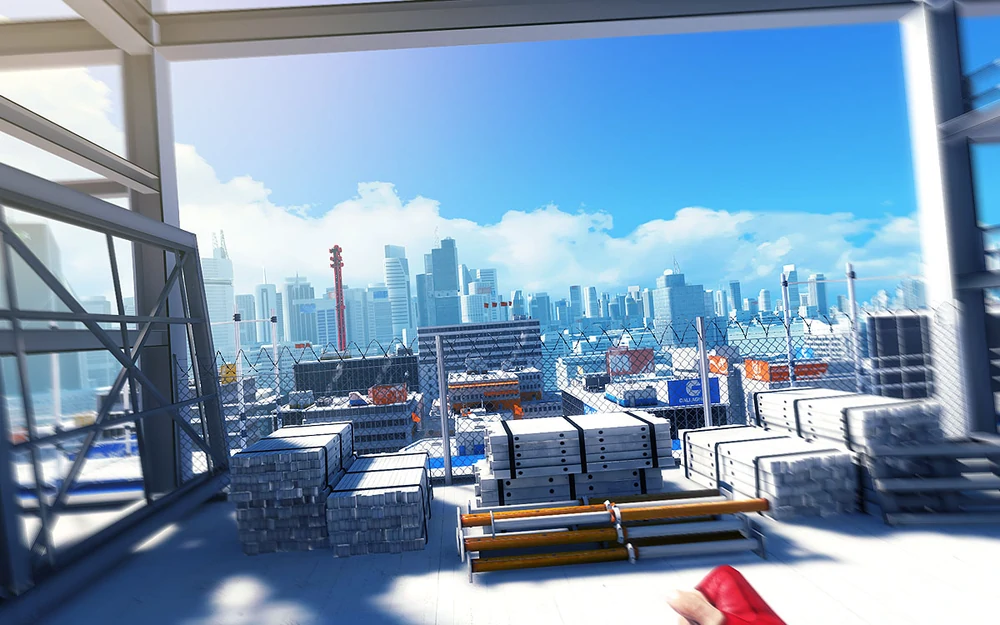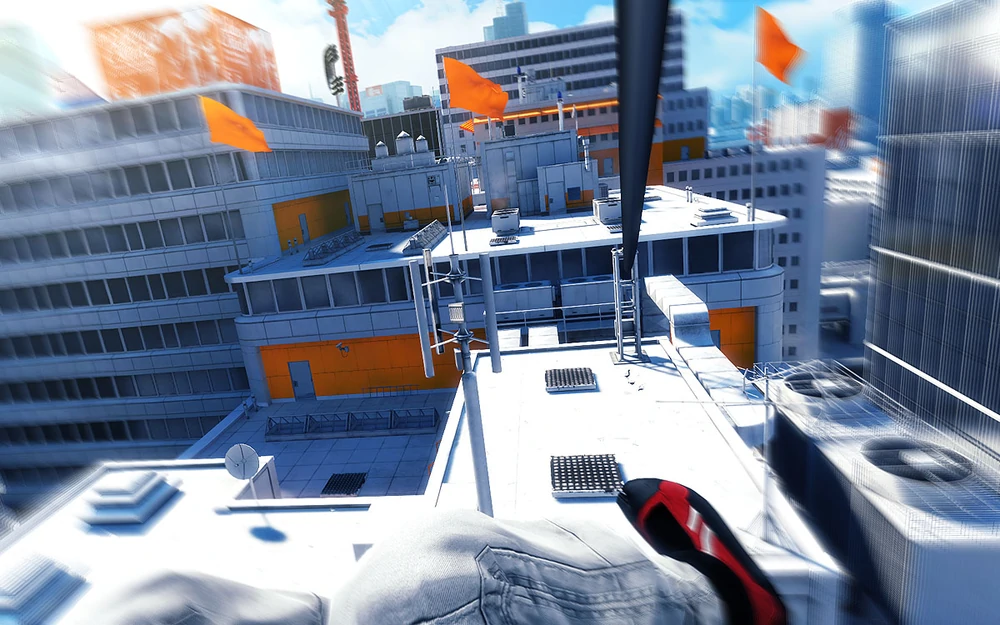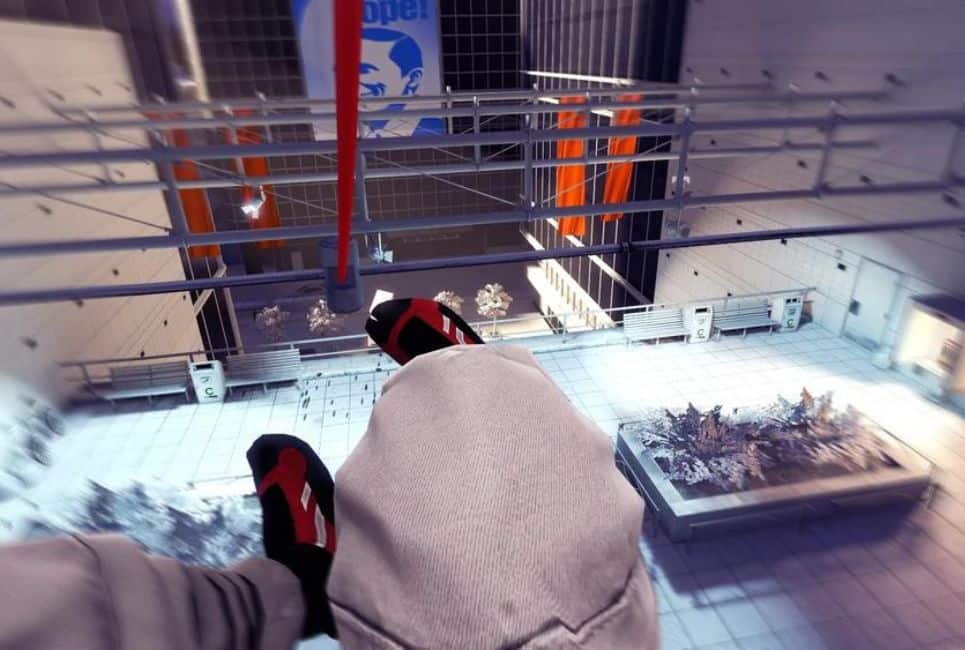- Dishonored Trophy Guide - December 25, 2022
- Deathloop Speedrun Guide - July 29, 2022
- Mirrors Edge Speedrun Guide - July 28, 2022
This Mirror’s Edge Any% speedrun guide is a bit different from what you might expect. That’s because Mirror’s Edge, as a speedrunning game, is pretty unique. The game’s whole premise is to go from point A to point B as fast as possible – there are no quests or objectives to do or anything of that nature.
It’s as linear as linear can be. That makes it quite challenging to write a guide about. Nobody wants to sit here and read 10,000 words of me telling them what buildings and walls they should be running on.
Instead, I’m going to focus heavily on the tech you’ll see being used throughout the run. Once you learn this movement tech, you can take it and learn the individual routes through each of the game’s chapters.
Combine those two together, and you’ll be able to complete a competent Any% run. Rather than relying on one sole Mirror’s Edge Any% speedrun guide, use this to supplement other sources of information.
Before The Run
As is the case with a lot of other speed runs, Mirror’s Edge requires us to perform constant, frame-precise pieces of movement to maintain optimal speed. In a game like Deathloop, that means binding the dash key to your mouse wheel so that you can spam it, allowing for frame-perfect inputs.
In Mirror’s Edge, we will assign jump to our mouse wheel in one direction and interact with it in the opposite direction.
Both of these binds are key for several pieces of tech and glitches that we’ll be performing throughout the run, so it’s mandatory. Do it before you even start practicing.
Tech
A side-Step Boost is a common and easy-to-perform piece of movement tech that you’ll be taking advantage of at various points throughout your Mirror’s Edge Any% speedrun. Its purpose is to help us in going from 0 km/h at a standstill to maximum running speed as quickly as possible.
Faith’s maximum running speed in Mirror’s Edge tops out at around 26 km/h. It takes about eight seconds to reach this velocity if you’re just running normally. Needless to say, this is less than ideal for a speedrun and far too slow. To get around that, we use a Side-Step Boost.
To Side-Step boost, you hold your A or D key and jump to do a little dodge to the side. This dodge is actually performed at full speed, so you go from 0 to around 26 km/h for the duration of the animation before losing the speed after the dodge.
However, if you turn your camera in the direction you’re dodging/stepping, you can run out of the animation. This allows you to maintain the speed that the Side-Step Boost gave you.
Anytime you come to a dead stop during the run – generally, off the back of cutscenes of loads, this is the piece of tech you’ll be doing to get up and moving again.
Bunny-Hopping

If you’re interested in Mirror’s Edge speedrunning, then it’s fairly safe to say that you’ve been around the gaming space for a little while. Long enough to know what bunny hopping is, anyway.
Bunny-Hopping in Mirror’s Edge works the same way as it does in other games. When Faith is in the air, the game’s physics system allows her to go faster as it doesn’t need to account for the friction of the ground.
So, if you continuously jump as you land while moving forward, you’ll be able to maintain a much faster speed than you would be running on the ground.
This piece of tech is literally as simple as spamming your mouse wheel while you’re running. There’s nothing to it at all. However, it’s only used in a few sections of the run. Generally speaking, there will almost always be another piece of tech faster than Bunny-Hopping, so it’s only used when there is no other viable option.
Wall Boost
Wall Boosting is another piece of tech designed to help us build up as much speed as possible. It’s usually combined with Kick Glitches to help us navigate massive gaps throughout the run.
When you jump out of a wall run normally, you’ll get a little bit of a speed boost. However, if you look into the wall as you jump out of the run, that speed boost is a lot bigger for some reason.
A Wall Boost is literally just that piece of tech. It’s jumping out of a wall run while ensuring your camera is facing the wall as much as possible.
As simple as this tech is, it has many applications during the run and is a trick you’ll want to spend a decent amount of time practicing on. Not only is it used in conjunction with Kick Glitches, but Wall Boosts are often chained together rapidly to build up an insane amount of speed. It’s your main speed-based tech, so get good at it.
Kick Glitch

The Kick Glitch is the most universal piece of movement tech in the entire Mirror’s Edge Any% speedrun. It’s going to be your main traversal tool so you’ll want to get good at it.
The glitch itself is something you would simply look over if you saw it and didn’t know what it was. To the untrained eye, it’s just a kick after a wall run. You’re here to become a trained eye, though – so here’s what’s actually going on when you see that wall run kick.
Whenever Faith kicks, the game creates a piece of the temporary floor beneath her for a frame or two. It’s just how the animation was programmed during development – it needs that floor to facilitate it. Normally, this wouldn’t be a big deal.
It only lasts for a couple of frames, and most players wouldn’t even notice it. In fact, Mirror’s Edge is far from the only game to use development tricks like this. As a speedrunner, you need a few frames to take advantage of a game mechanic.
Given that we’ve got a bit of floor for a frame, we’re able to input whatever we would be able to do standing on a regular floor. We can side-step, slide, and, more importantly – jump.
If you pay attention to any clip of someone performing a Kick Glitch, you’ll notice that not only do they kick after leaving the wall run, but they also jump afterward. This gives them far more distance than they would otherwise get. When that’s combined with another movement tech to increase Faith’s speed, several large gaps in the game can be jumped, allowing you to skip large portions of each chapter. That is the heart and soul of the Mirror’s Edge speedrun.
So, the Kick Glitch is when you perform a wall run and then kick off of it, creating a floor beneath Faith for a frame. You input a jump during that frame – allowing Faith to wall run into a kick into a jump. This lets you cover a lot more distance than you would otherwise be able to.
The Kick Glitch only works with the wall-run side-kick animation. It doesn’t work with the neutral kick or dropkick animations – hence why it can only be done off of a wall run.
Now, with the number of Kick Glitches you’ll be performing in the run, you’ll need a way to get around the need for constant frame-perfect inputs. For that, you’ll be rebinding your mouse’s scroll wheel to jump; either scroll up or scroll down (you’ll be using the other direction for another glitch).
When you’re performing the Kick Glitch, just spam-scroll your mouse wheel, and you should almost always hit the jump on the right frame.
If there’s one piece of tech that you want to practice, make it this one. It’s the most important and prominent piece of movement you’ll use throughout the Mirror’s Edge’s nine chapters.
Use Glitch
The last main piece of tech I will go over isn’t related to movement at all. Instead, it’s related to skipping the animations that you get whenever you interact with a valve or button.
This glitch is simple to perform. It requires you to use the interact button twice on the same frame. This is done by binding your scroll wheel to interact – just make sure it’s opposite to your jumping binding.
This is used in a few different places throughout the run, but the main and most obvious use is for the elevators that frequently come up throughout the game. Typically, interacting with the elevator disables the majority of our controls and makes us wait for the game to load before we can continue, all under the disguise of using a regular elevator.
However, if you perform the Use Glitch on the elevator buttons, we get around two seconds of freedom inside the elevator before the game removes our controls. This typically lets us get out of bounds on top of the elevator. This further lets us sequence break the game and skip massive chunks of several different chapters.
Conclusion
Mirror’s Edge is a pretty linear game. There are no objectives for you to fulfill. It’s literally “get from point A to point B.” From a speedrunning perspective, this might draw mixed opinions. Some of you may love the simplistic nature of the run, while others may lament the lack of technicality that goes into it. There are no real tricks for you to learn. It’s just movement tech and the route.
On the other hand, that makes Mirror’s Edge Any% a great introduction to the world of speedrunning in general. This is a great place to start if you’re new to the scene. If you’ve been around, hopefully, this guide helped highlight and explain some of the movement tech that goes into the run.
Of course, I haven’t covered the route through each chapter. That would be impossible with text alone, so I highly recommend you check out the various runs on the Any% leaderboard and this YouTube guide by Walrus that goes over the route for every chapter from a beginner’s perspective.
FAQ
Question: How Long is Mirror’s Edge?
Answer: Mirror’s Edge is around six hours in length to play normally from start to finish. The speedrun world record, however, clocks in at between 20 and 25 minutes. A full run might take you close to an hour for a beginner.
Question: Is Mirror’s Edge a Good Speedrunning Game?
Answer: The whole premise of Mirror’s Edge as a game is to run as fast as possible. So, naturally, it’s a great speed-running game. It’s not as skip and glitch heavy as most other speedruns – instead, relying on movement mechanics as you traverse the chapters from A to B.
Question: How do you Speedrun Mirror’s Edge?
Answer: To speedrun Mirror’s Edge, you have to boot up the game and get going. There’s no right or wrong way to start speedrunning a game. Just practice the tech for a few days, then put it all together. Go back to practicing, rinse, and repeat until you’re the world record holder.
Continue reading:
Best GDQ Speedruns Guide – Condensing a Decade of Speedruns Down Into the Best of the Best
Getting Over It Speedrun Guide – How to Beat Bennett Foddy’s Gruelling Climb In Style!



